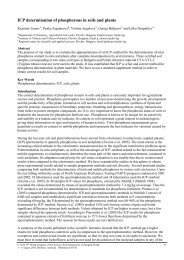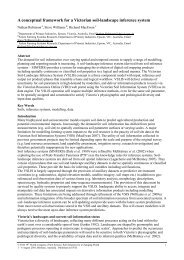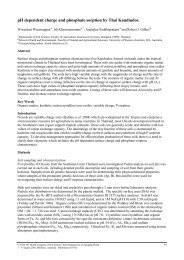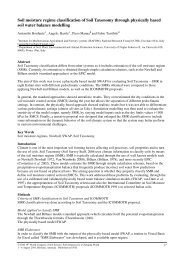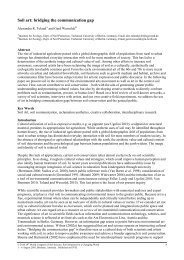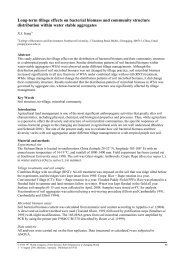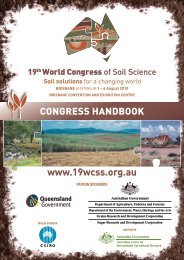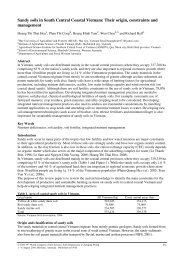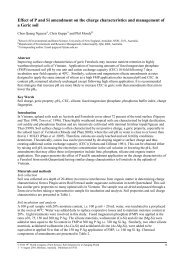Preliminary Study on Phosphate Solubilization and K-releasing ...
Preliminary Study on Phosphate Solubilization and K-releasing ...
Preliminary Study on Phosphate Solubilization and K-releasing ...
You also want an ePaper? Increase the reach of your titles
YUMPU automatically turns print PDFs into web optimized ePapers that Google loves.
<str<strong>on</strong>g>Preliminary</str<strong>on</strong>g> <str<strong>on</strong>g>Study</str<strong>on</strong>g> <strong>on</strong> <strong>Phosphate</strong> Solubilizati<strong>on</strong> <strong>and</strong> K-<strong>releasing</strong> Abilities of<br />
Rhizobium tropici Martinez-Romero et al. Strains from Woody Legumes<br />
Jiao Ruzhen, Peng Yuh<strong>on</strong>g<br />
Research Institute of Forestry, Chinese Academy of Forestry, Beijing 100091<br />
Abstract<br />
Experiments were c<strong>on</strong>ducted <strong>on</strong> phosphate solubilizati<strong>on</strong> <strong>and</strong> K-<strong>releasing</strong> abilities of st<strong>and</strong>ard strain<br />
CGMCC 1.2540 T of Rhizobium tropici Martinez-Romero et al. (1991) <strong>and</strong> 22 strains of Rhizobium tropici<br />
Martinez-Romero et al. (1991) which were separated from woody legume plants in the Jianfengling Nature<br />
Reserve, Hainan Province. N<strong>on</strong>e of the tested strains have shown the ability to solubilize organic phosphate<br />
<strong>on</strong> M<strong>on</strong>gina organic culture medium, but have dem<strong>on</strong>strated K-<strong>releasing</strong> ability <strong>on</strong> K-<strong>releasing</strong> culture<br />
medium. 20 strains have the ability to solubilize inorganic phosphate of Ca 3 (PO 4 ) 2 . Different strains indicate<br />
great differences in phosphate solubilizati<strong>on</strong> <strong>and</strong> K-<strong>releasing</strong> abilities, particularly so in phosphate<br />
solubilizati<strong>on</strong>. The weakest ability of phosphate solubilizati<strong>on</strong> by the strain of Caf438 <strong>and</strong> the str<strong>on</strong>gest by<br />
Caf341 increased the available phosphoru in the medium by 0.796 mg L -1 <strong>and</strong> 628.57 mg L -1 respectively, of<br />
which the difference is 788 times; The abilities of phosphate solubilizati<strong>on</strong> <strong>and</strong> K-<strong>releasing</strong> are irrelevant of<br />
hosts. The strains of Rhizobium tropici Martinez-Romero et al. (1991) <strong>on</strong> the same host show apparent<br />
differences <strong>on</strong> phosphate solubilizati<strong>on</strong> <strong>and</strong> K-<strong>releasing</strong> abilities. The strains of Caf336, Caf344 <strong>and</strong> Caf414<br />
are provided with more powerful phosphate solubilizati<strong>on</strong> <strong>and</strong> K-<strong>releasing</strong> abilities.<br />
Key Words<br />
Woody legume, rhizobia, phosphate-solubilized halo, phosphate solubilizati<strong>on</strong>, c<strong>on</strong>tent of available P, K-<br />
<strong>releasing</strong> ability, c<strong>on</strong>tent of available K<br />
Introducti<strong>on</strong><br />
The symbiosis of rhizobia <strong>and</strong> legume plants is the str<strong>on</strong>gest system in bio-fixati<strong>on</strong> of nitrogen, of which the<br />
nitrogen fixed accounts for 65% of all the nitrogen fixed biologically (Danming et al., 2002; Zabran, 1999;<br />
Denarie <strong>and</strong> Roche, 1991). Moreover, the developed root system of woody legumes make them str<strong>on</strong>ger in<br />
nitrogen fixati<strong>on</strong> in comparis<strong>on</strong> with grain legumes of soybean, peanuts, broad bean <strong>and</strong> others (80-210 kgN/<br />
ha.a), which is 43-581 kgN/ha.a (Fuli <strong>and</strong> Zhengjia, 2000). The current studies <strong>on</strong> rhizobia are<br />
c<strong>on</strong>centrated <strong>on</strong> the functi<strong>on</strong> of nitrogen fixati<strong>on</strong> <strong>and</strong> their relati<strong>on</strong>ship with host plants, while the abilities of<br />
their phosphate solubilizati<strong>on</strong> <strong>and</strong> K-<strong>releasing</strong> are less dealt with. N, P <strong>and</strong> K are three main essential<br />
nutriti<strong>on</strong> elements for plants. In China, the total c<strong>on</strong>tent of P in soil is high, but of which 95% is not available<br />
in the forms of aluminnosilicate, phosphorite, etc. that is difficult to be used directly by plants. Soil is a<br />
natural reserve of potassium, the K c<strong>on</strong>tent of the tilled soil layer is about 26,100 kg/hm 2 , of which 90%<br />
exists in potassium feldspar, mica <strong>and</strong> other silicate minerals. Those are stable minerals that could not be<br />
used directly by plants, leading to the phenomen<strong>on</strong> of K rich but available K lacking in soil. <strong>Phosphate</strong><br />
solubilizing microbe c<strong>on</strong>vert <strong>and</strong> make available P in soil <strong>and</strong> the study of P solubilizati<strong>on</strong> by bacteria<br />
mainly deals with silicate bacteria (Baogui <strong>and</strong> Bin, 2005; Jian et al., 2000; Fengding et al., 1997). But those<br />
microbes are found in a free state in soil, which hinders the c<strong>on</strong>versi<strong>on</strong> <strong>and</strong> use of unavailable P <strong>and</strong> K in<br />
soil, owing to the competiti<strong>on</strong> with indigenous microbes <strong>and</strong> their survival time. P solubilizati<strong>on</strong> <strong>and</strong> K<br />
<strong>releasing</strong> by rhizobia is seldom reported. Rhizobium <strong>and</strong> its symbiotic plant forms a specific structure – root<br />
nodule, which is endowed with a unique advantage in survival time <strong>and</strong> competibility compared with other<br />
bacteria. The screening of P solubilizing <strong>and</strong> K-<strong>releasing</strong> rhizobia strains has high academic, ecological <strong>and</strong><br />
ec<strong>on</strong>omic values.<br />
Material <strong>and</strong> Methods<br />
Bacterial strains<br />
The 22 strains of Rhizobium tropici Martinez-Romero et al. (1991) were isolated from the root nodules of<br />
legume plants in the Jianfengling Nature Reserve, Hainan Province. The strains of Caf224, Caf225, Caf226<br />
were isolated from Ormosia balansae Drake, Caf276, Caf278 <strong>and</strong> Caf279 were isolated from Desmodium<br />
triquetrum (Linn.) DC., Caf333, Caf334, Caf336 were isolated from Desmodium heterocarp<strong>on</strong> (L.) DC.,<br />
Caf341, Caf344 were isolated from Indigofera suffruticosa Mill. Caf414, Caf415, Caf416 were isolated from<br />
Ormosia semicastrata Hance f. Litchifolia, <strong>and</strong> Caf436, Caf437, Caf438, Caf439, Caf440, Caf443, Caf444,<br />
<strong>and</strong> Caf446 were isolated from Acacia mangium Willd., while st<strong>and</strong>ard strain CGMCC 1.2540T was from<br />
cgmcc.<br />
© 2010 19 th World C<strong>on</strong>gress of Soil Science, Soil Soluti<strong>on</strong>s for a Changing World<br />
1 – 6 August 2010, Brisbane, Australia. Published <strong>on</strong> DVD.<br />
104
Media <strong>and</strong> methods<br />
1. Bevel culture media: Rhizobia culture media-1 (Yuguang, 2007).<br />
2. Selecting strains of inorganic phosphate-solubilized <strong>on</strong> PKO medium <strong>and</strong> solubilize organic P<br />
(lecithin) <strong>on</strong> M<strong>on</strong>gina organic culture medium. Checking up the phosphate-solubilized halo of the<br />
tested strains<br />
3. Liquid culture medium (Chuanjin <strong>and</strong> Lin, 2002).<br />
4. The inorganic phosphate culture medium:Glucose 10 g, (NH 4 ) 2 SO 4 0.5 g, MgSO 4·7H 2 O 0.3 g, NaCl<br />
0.3 g, KCl 0.3 g, FeSO 4·7H 2 O 0.03 g, MnSO 4·7H 2 O 0.03 g, Ca 3 (PO 4 ) 2 5 g, distilled water 1000 mL,<br />
pH 7.2, 110 o C Sterilizati<strong>on</strong> for 30 min.<br />
5. The Organic phosphate culture medium: Glucose 10 g, (NH 4 ) 2 SO 4 0.5 g, MgSO 4·7H 2 O 0.3 g, NaCl<br />
0.3 g, KCl 0.3 g, FeSO 4·7H 2 O 0.03 g, MnSO 4·7H 2 O 0.03g, lecithin 2 g, CaCO 3 5 g, distilled water<br />
1000 mL, pH 7.2, 110 o C , Sterilizati<strong>on</strong> for 30 min.<br />
6. Determining available P c<strong>on</strong>tent of the culture soluti<strong>on</strong> used Mo anti-antim<strong>on</strong>y colorimetry.<br />
7. Ashby culture medium (Yuguang, 2007)<br />
8. KH 2 PO 4 0.2 g, MgSO 4 7H 2 O 0.2 g, NaCl 0.2 g, CaCO 3 5.0 g mannite 10 g, CaSO 4 2H 2 O 0.1 g, distilled<br />
water 1.0L, pH7.0. Choose the col<strong>on</strong>y with slime.<br />
9. K-<strong>releasing</strong> culture medium (Institute of Soil Science, 1985)<br />
10. Saccharose 5.0 g, Na 2 HPO 4 2.0 g, MgSO 4· 7H 2 O 0.5g FeCl 3 0.005 g, CaCO 3 0.1 g, KAlSi 3 O 8 5 g,<br />
distilled water1.0 L. Determine available P c<strong>on</strong>tent of the culture soluti<strong>on</strong> with Atomic Absorpti<strong>on</strong><br />
Spectrophotometer Method.<br />
Data processing<br />
Data processing using Excel <strong>and</strong> Spss16.0<br />
Result<br />
Selecting the rhizobia strains of phosphate solubilizati<strong>on</strong><br />
Checking the phosphate-solubilized halo.On PKO inorganic medium flat, 20 strains have generated<br />
phosphate-solubilized halo except Caf226, Caf438 <strong>and</strong> CGMCC 1.2540T. The result shows that the 20<br />
strains could solubilize nullificati<strong>on</strong> P (Ca 3 (PO 4 ) 2 ). On M<strong>on</strong>gina organic culture medium, all of 23 tested<br />
strains show no phosphate-solubilized halo. Figure1 shows the phosphate-solubilized halo of Caf341 strain<br />
On PKO inorganic medium flat.<br />
Figure 1. <strong>Phosphate</strong>-solubilized halo of Caf341 strain.<br />
Figure 2. Caf224 col<strong>on</strong>y <strong>on</strong> potassium medium culture.<br />
The ability of diferent Rhizobia isolated at solubilizing inorganic phosphate<br />
Table 1. The Ability of Diferent Rhizobia Isolated at Solubilizing Inorganic <strong>Phosphate</strong>.<br />
Strains C<strong>on</strong>tent of available P of the Rhizobia<br />
culture with Ca 3 (PO 4 ) 2 as <strong>on</strong>ly P source<br />
Strains C<strong>on</strong>tent of available P of the Rhizobia<br />
culture with Ca 3 (PO 4 ) 2 as <strong>on</strong>ly P source<br />
Caf224 13.81 ** Caf415 14.44 **<br />
Caf225 22.18 ** Caf416 45.20 **<br />
Caf226 2.51 Caf436 585.06 **<br />
Caf276 528.56 Caf437 418.69 **<br />
Caf278 421.85 Caf438 1.86<br />
Caf279 101.69 ** Caf439 139.36 **<br />
Caf333 239.79 ** Caf440 170.75 **<br />
Caf334 618.40 ** Caf443 264.90 **<br />
Caf336 403.01 ** Caf444 499.31 **<br />
Caf341 629.63 ** Caf446 126.80 **<br />
Caf344 426.87 ** CGMCC1.2<br />
540 T 1.89<br />
Caf414 422.35 ** ck 1.06<br />
**level0.011<br />
© 2010 19 th World C<strong>on</strong>gress of Soil Science, Soil Soluti<strong>on</strong>s for a Changing World<br />
1 – 6 August 2010, Brisbane, Australia. Published <strong>on</strong> DVD.<br />
105
In Table 1, c<strong>on</strong>tent of available P of 20 strains with phosphate-solubilized halo is higher than that of the<br />
c<strong>on</strong>trol evidently. Different strains indicate great differences in phosphate solubilizati<strong>on</strong>. The weakest ability<br />
of phosphate solubilizati<strong>on</strong> by the strain of Caf438 <strong>and</strong> the str<strong>on</strong>gest by Caf341 increased the available<br />
phosphate in the medium by 0.796 mg L -1 <strong>and</strong> 628.57 mg L -1 respectively, of which the difference is as great<br />
as over 788 times; The c<strong>on</strong>tents of available P in culture liquid of Caf341, Caf334, Caf436, Caf276, Caf444,<br />
Caf344, Caf414, Caf278, Caf437 <strong>and</strong> Caf336 are more than 400 mg L -1 .All of 23 strains are Rhizobium<br />
tropici Martinez-Romero et al. (1991) The result shows that different strains of same species have different<br />
abilities of phosphate solubilizati<strong>on</strong>.<br />
C<strong>on</strong>t ent of avai l abl e P(mg. L- 1)<br />
7 0 0<br />
6 0 0<br />
5 0 0<br />
4 0 0<br />
3 0 0<br />
2 0 0<br />
1 0 0<br />
0<br />
5 8 5 . 0 6<br />
1 . 8 5 6<br />
1 3 9 . 3 6<br />
1 7 0 . 7 5<br />
2 6 4 . 9<br />
4 9 9 . 3 1<br />
1 2 6 . 8<br />
c a f 4 3 6 c a f 4 3 8 c a f 4 3 9 c a f 4 4 0 c a f 4 4 3 c a f 4 4 4 c a f 4 4 6<br />
s t r a i n<br />
Figure3. C<strong>on</strong>tents of available P of the Rhizobia culture (host: Acacia mangium Willd.)<br />
The abilities of phosphate solubilizati<strong>on</strong> of strains which were isolated from the same host are different.<br />
Caf436 <strong>and</strong> Caf438 were isolated from the root nodule of Acacia mangium Willd, which have increased the<br />
available phosphate in the culture liquid by 0.796 mg L -1 <strong>and</strong> 584 mg L -1 respectively, of which the<br />
difference is as great as over 733 times.<br />
Selecti<strong>on</strong> of strains with K-<strong>releasing</strong> ability<br />
All the 23 tested strains could grow <strong>on</strong> Ashby culture medium <strong>and</strong> K-<strong>releasing</strong> culture medium. All of the<br />
col<strong>on</strong>ies are smooth, transparent <strong>and</strong> with slime. This shows that all strains could utilize K of KAlSi 3 O 8 . See<br />
Figure 2.<br />
Determinati<strong>on</strong> of K-<strong>releasing</strong> ability<br />
The c<strong>on</strong>tent of available potassium from the filtrates of culture were determined with Atomic Absorpti<strong>on</strong><br />
Spectrophotometer Method (Table 2). All of the tested strains were apparently different in K-<strong>releasing</strong><br />
ability from the c<strong>on</strong>trol (F0.01=0.000
The correlati<strong>on</strong> of abilities <strong>on</strong> phosphate solubilizati<strong>on</strong> <strong>and</strong> potassium <strong>releasing</strong><br />
Table 3. The Correlati<strong>on</strong> of Abilities <strong>on</strong> P Solubilizati<strong>on</strong> <strong>and</strong> K Releasing.<br />
VAR00002<br />
VAR00003<br />
C<strong>on</strong>tent of available K<br />
C<strong>on</strong>tent of available P<br />
Pears<strong>on</strong> Correlati<strong>on</strong> 1 -.007<br />
Sig. (2-tailed) .954<br />
N 72 72<br />
Pears<strong>on</strong> Correlati<strong>on</strong> -.007 1<br />
Sig. (2-tailed) .954<br />
N 72 72<br />
It is seen from Table 3, the abilities of strains <strong>on</strong> phosphate solubilizati<strong>on</strong> <strong>and</strong> K–<strong>releasing</strong> are irrelevant in between.<br />
The result shows that phosphate solubilizati<strong>on</strong> <strong>and</strong> K–<strong>releasing</strong> are effected by different mechanisms.<br />
Results <strong>and</strong> Discussi<strong>on</strong><br />
1 The 22 strains which were separated from woody legumes in the Jianfengling Nature Reserve, Hainan<br />
Province have the ability to release K, <strong>and</strong> of which 20 have the ability to solubilize inorganic phosphate of<br />
Ca 3 (PO 4 ) 2 . The strains with str<strong>on</strong>g P solubilizati<strong>on</strong> ability are Caf341, Caf334, Caf436, Caf276, Caf444,<br />
Caf344, Caf414, Caf278, Caf437 <strong>and</strong> Caf336.<br />
2 Different strains dem<strong>on</strong>strate great differences in the abilities to c<strong>on</strong>vert P <strong>and</strong> K, particularly so in the<br />
c<strong>on</strong>versi<strong>on</strong> of P. The weakest ability of phosphate solubilizati<strong>on</strong> by the strain of Caf438 <strong>and</strong> the str<strong>on</strong>gest by<br />
Caf341 increased the available phosphate in the medium by 0.796 mg L -1 <strong>and</strong> 628.57 mg L -1 respectively, of<br />
which the difference is as great as over 788 times.<br />
3 The abilities of phosphate solubilizati<strong>on</strong> <strong>and</strong> K-<strong>releasing</strong> are irrelevant of hosts. The strains of Caf436,<br />
Caf437, Caf438, Caf439, Caf440, Caf443, Caf444 <strong>and</strong> Caf446 were all <strong>on</strong> the same host of Acacia mangium<br />
Willd, which, however, present a sharp c<strong>on</strong>trast in between in the c<strong>on</strong>tents of available P <strong>and</strong> fast K.<br />
4 Different strains of the same species indicate great differences in phosphate solubilizati<strong>on</strong> <strong>and</strong> K-<strong>releasing</strong><br />
abilities. All the strains tested are of Rhizobium tropici Martinez-Romero et al. (1991) but different strains<br />
show a great c<strong>on</strong>trast of available P <strong>and</strong> fast K in the culture.<br />
5 The abilities of rhizobia in P solubilizati<strong>on</strong> <strong>and</strong> K–<strong>releasing</strong> are not correlated, which indicates different<br />
mechanisms for P solubilizati<strong>on</strong> <strong>and</strong> K–<strong>releasing</strong>, awaiting further study.<br />
6 N<strong>on</strong>e of the rhizobia of 26 strains tested in the experiment is able to solubilize the lecithin of organic<br />
phosphate. Whether the rhizobia can solubilize other organic phosphates calls for further experiment.<br />
References<br />
Martinez-Romero E, Segovia L, Mercante FM, Franco AA, Graham P, Pardo MA (1991) Rhizobium tropici, a<br />
novel species nodulating Phaseolusvulgaris L. beans <strong>and</strong> Leucaena sp. trees. Int. J. Syst. Bacteriol. 41, 417-<br />
426.<br />
Chen Danming, Zeng Zhaohai, Sui Xinhua (2002) Screening of high efficient symbiotic rhizobium <strong>on</strong> alfalfa.<br />
Pratacultural Science 9(6), 27-31.<br />
Zabran H H (1999) Rhizobium-legume symbiosis <strong>and</strong> nitrogen fixati<strong>on</strong> under severe c<strong>on</strong>diti<strong>on</strong> <strong>and</strong> in arid<br />
climate.Microbiol. Mol. Biol. Rev. 63, 968-989.<br />
Denarie J, Roche P (1991) Rhizobium Nodulati<strong>on</strong> Signals, Verma Ps.Molecular Signals in Plant-Microbe<br />
Communicati<strong>on</strong>s. CRC Press, L<strong>on</strong>d<strong>on</strong>.<br />
Li Fuli, Hu Zhengjia (2000) Microorganism. Beijing, China Agriculture Press, China.<br />
Jiang Baogui, Zhao Bin (2005) Screening <strong>and</strong> Identificati<strong>on</strong> of the Bacterium Which Have High Efficiency <strong>on</strong><br />
Resolving <strong>Phosphate</strong> <strong>and</strong> Potassium <strong>and</strong> in Nitrogen Fixati<strong>on</strong>. Journal of Huazh<strong>on</strong>g Agricultural University<br />
24(1), 43-48.<br />
Li Fengding, Hao Zhengran, Yang Zeyuan (1997) Studies <strong>on</strong> the ability of silicate bacterium 884l strain<br />
dissolving potassium. Acta Microbiologica Sinica 24(1), 79-81.<br />
L<strong>on</strong>g Jian, Li Juan, L<strong>on</strong>g Minglan (2000) Role of silicate bacteria in <strong>releasing</strong> potassium from minerals <strong>and</strong> soils.<br />
Journal of Guizhou Normal University (Natural Sciences) 18(1), 77-81.<br />
Zhou Yuguang (2007) China Catalogue of Cultures. Chemical Industry Press, China.<br />
Zheng Chuanjin, Huang Lin (2002) A study <strong>on</strong> the capacity of Bacillus Megaterium in dissolving P compounds,<br />
Acta Agriculturae Universitis Jiangxiensis 24(2).<br />
Institute of Soil Science, Chinese Academy of Sciences (1985) Methods for <str<strong>on</strong>g>Study</str<strong>on</strong>g>ing Soil Microorganisms.<br />
Science Publishing House, Beijing, China.<br />
© 2010 19 th World C<strong>on</strong>gress of Soil Science, Soil Soluti<strong>on</strong>s for a Changing World<br />
1 – 6 August 2010, Brisbane, Australia. Published <strong>on</strong> DVD.<br />
107



